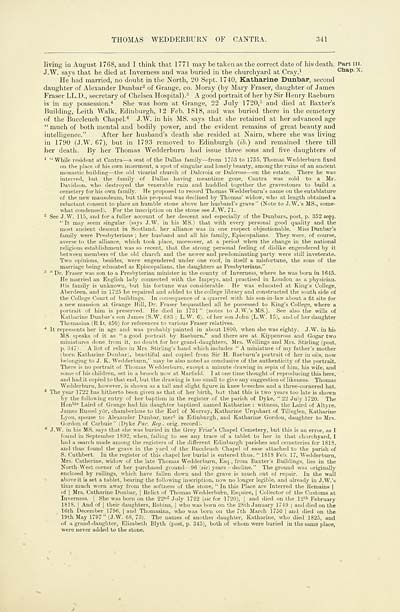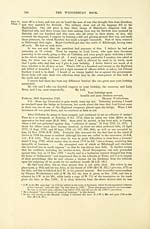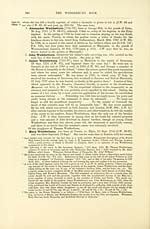Wedderburn book > History
(475) Page 341
Download files
Complete book:
Individual page:
Thumbnail gallery: Grid view | List view

THOMAS WEDDERBURN OF CANTRA. 341
living in August 1768, and I think that 1771 may he taken as the correct date of his death. Partm.
J.W. says that he died at Inverness and was buried in the churchyard at Cray. 1 Chap. x.
He had married, no doubt in the North, 20 Sept. 1740, Katharine Dunbar, second
•daughter of Alexander Dunbar 2 of Grange, co. Moray (by Mary Fraser, daughter of James
Fraser LL.D., secretary of Chelsea Hospital). 3 A good portrait of her by Sir Henry Raeburn
is in my possession. 4 She was born at Grange, 22 July 1720, 5 and died at Baxter's
Building, Leith Walk, Edinburgh, 12 Feb. 1818, and was buried there in the cemetery
of the Buccleuch Chapel. 6 J.W. in his MS. says that she retained at her advanced age
" much of both mental and bodily power, and the evident remains of great beauty and
intelligence." After her husband's death she resided at Nairn, where she was living
in 1790 (J.W. 67), but in 1793 removed to Edinburgh (ib.) and remained there till
her death. By her Thomas Wedderburn had issue three sons and five daughters of
1 " While resident at Cantra — a seat of the Dallas family — from 1753 to 1755, Thomas Wedderburn fixed
on the place of his own interment, a spot of singular and lonely beauty, among the ruins of an ancient
monastic building — the old vicarial church of Dalcroix or Dalcross — on the estate. There he was
interred, but the family of Dallas having meantime gone, Cantra was sold to a Mr.
Davidson, who destroyed the venerable ruin and huddled together the gravestones to build a
cemetery for his own family. He proposed to record Thomas Wedderburn's name on the entablature
of the new mausoleum, but this proposal was declined by Thomas' widow, who at length obtained a
reluctant consent to place an humble stone above her husband's grave" (Note to J.W.'s MS., some-
what condensed). For the inscription on the stone see J.W. 71.
4 See J.W. 115, and for a fuller account of her descent and especially of the Duubars, post, p. 352 seqq.
"It may seem singular (says J.W. in his MS.) that with every personal good quality and the
most ancient descent in Scotland, her alliance was in one respect objectionable. Miss Dunbar's
family were Presbyterians ; her husband and all his family, Episcopalians. They were, of course,
averse to the alliance, which took place, moreover, at a period when the change in the national
religious establishment was so recent, that the strong personal feeling of dislike engendered by it
between members of the old church and the newer and predominating party were still inveterate.
Two opinions, besides, were engendered under one roof, in itself a misfortune, the sons of the
marriage being educated as Episcopalians, the daughters as Presbyterians."
s " Dr. Fraser was son to a Presbyterian minister in the county of Inverness, where he was born in 1645.
He married an English lady connected with the Impeys, and practised in London as a physician.
His family is unknown, but his fortune was considerable. He was educated at King's College,
Aberdeen, and in 1725 he repaired and added to the college library and constructed the south side of
the College Court of buildings. In consequence of a quarrel with his son-in-law about a fit site for
a new mausion at Grange Hill, Dr. Fraser bequeathed all he possessed to King's College, where a
portrait of him is preserved. He died in 1731" (notes to J.W.'s MS.). See also the wills of
Katharine Dunbar's son James (S.W. 683 ; L. W. 6), of her son John (L.W. 15), and of her daughter
Thomasiua (R.D. 450) for references to various Fraser relatives.
4 It represents her in age and was probably painted in about 1800, when she was eighty. J.W. in his
MS. speaks of it as " a good portrait by Raeburn," and there are at Kippenross and Gogar two
miniatures done from it, no doubt for her grand-daughters, Mrs. Wellings and Mrs. Stirling (post,
p. 347). A list of relics in Mrs. Stirling's hand which includes "A miniature of my father's mother
(born Katharine Dunbar), beautiful and copied from Sir H. Raeburn's portrait of her in oils, now
belonging to J. K. Wedderburn," may be also noted as conclusive of the authenticity of the portrait.
There is no portrait of Thomas Wedderburn, except a minute drawing in sepia of him, his wife, and
some of his children, set in a brooch now at Marfield. I at one time thought of reproducing this here,
and had it copied to that end, but the drawing is too small to give any suggestion of likeness. Thomas
Wedderburn, however, is shown as a tall and slight figure in knee breeches and a three-cornered hat.
s The year 1722 has hitherto been given as that of her birth, but that this is two years too late is shown
by the following entry of her baptism in the register of the parish of Dyke, " 22 July 1720. The
Hon ble Laird of Grange had his daughter baptized named Katharine : witness, the Laird of Altyre.
James Russel yor, chamberlane to the Earl of Murray, Katharine Urquhart of Tilleglen, Katharine
Lyon, spouse to Alexander Dunbar, mer' in Edinburgh, and Katharine Gordon, daughter to Mrs.
Gordon of Carbuie" (Dyke Par. Jieg., orig. record).
■* J.W. in his MS. says that she was buried in the Grey Friar's Chapel Cemetery, but this is an error, as I
found in September 1892, when, failing to see any trace of a tablet to her in that churchyard, I
had a search made among the registers of the different Edinburgh parishes and cemeteries for 1818,
and thus found the grave in the yard of the Buccleuch Chapel of ease attached to the parish of
S. Cuthbert. In the register of this chapel her burial is entered thus, " 1818 Feb. 17, Wedderburn,
Mrs. Catherine, widow of the late Thomas Wedderburn, Esq., from Baxter's Buildings, lies in the
North- West corner of her purchased ground — 96 (sic) years— decline. " The ground was originally
enclosed by railings, which have fallen down and the grave is much out of repair. In the wall
above it is set a tablet, bearing the following inscription, now no longer legible, and already in J.W.'s
time much worn away from the softness of the stone, " In this Place are Interred the Remains |
of | Mrs. Catharine Dunbar, | Relict of Thomas Wedderburn, Esquire, | Collector of the Customs at
Inverness. | She was born on the 22 nd July 1722 [sic for 1720), | and died on the 12 th February
1818. | And of | their daughters, Robiua, | who was born on the 28 th January 1749 j and died on the
16th December 1796, | and Thomasiua, who was born on the 7th March 1750 | and died on the
19th May 1797" (J.W. 68, 73). The names of another daughter, Katharine, who died 1825, and
of a grand-daughter, Elizabeth Blyth (post, p. 343), both of whom were buried in the same place,
were never added to the stone.
living in August 1768, and I think that 1771 may he taken as the correct date of his death. Partm.
J.W. says that he died at Inverness and was buried in the churchyard at Cray. 1 Chap. x.
He had married, no doubt in the North, 20 Sept. 1740, Katharine Dunbar, second
•daughter of Alexander Dunbar 2 of Grange, co. Moray (by Mary Fraser, daughter of James
Fraser LL.D., secretary of Chelsea Hospital). 3 A good portrait of her by Sir Henry Raeburn
is in my possession. 4 She was born at Grange, 22 July 1720, 5 and died at Baxter's
Building, Leith Walk, Edinburgh, 12 Feb. 1818, and was buried there in the cemetery
of the Buccleuch Chapel. 6 J.W. in his MS. says that she retained at her advanced age
" much of both mental and bodily power, and the evident remains of great beauty and
intelligence." After her husband's death she resided at Nairn, where she was living
in 1790 (J.W. 67), but in 1793 removed to Edinburgh (ib.) and remained there till
her death. By her Thomas Wedderburn had issue three sons and five daughters of
1 " While resident at Cantra — a seat of the Dallas family — from 1753 to 1755, Thomas Wedderburn fixed
on the place of his own interment, a spot of singular and lonely beauty, among the ruins of an ancient
monastic building — the old vicarial church of Dalcroix or Dalcross — on the estate. There he was
interred, but the family of Dallas having meantime gone, Cantra was sold to a Mr.
Davidson, who destroyed the venerable ruin and huddled together the gravestones to build a
cemetery for his own family. He proposed to record Thomas Wedderburn's name on the entablature
of the new mausoleum, but this proposal was declined by Thomas' widow, who at length obtained a
reluctant consent to place an humble stone above her husband's grave" (Note to J.W.'s MS., some-
what condensed). For the inscription on the stone see J.W. 71.
4 See J.W. 115, and for a fuller account of her descent and especially of the Duubars, post, p. 352 seqq.
"It may seem singular (says J.W. in his MS.) that with every personal good quality and the
most ancient descent in Scotland, her alliance was in one respect objectionable. Miss Dunbar's
family were Presbyterians ; her husband and all his family, Episcopalians. They were, of course,
averse to the alliance, which took place, moreover, at a period when the change in the national
religious establishment was so recent, that the strong personal feeling of dislike engendered by it
between members of the old church and the newer and predominating party were still inveterate.
Two opinions, besides, were engendered under one roof, in itself a misfortune, the sons of the
marriage being educated as Episcopalians, the daughters as Presbyterians."
s " Dr. Fraser was son to a Presbyterian minister in the county of Inverness, where he was born in 1645.
He married an English lady connected with the Impeys, and practised in London as a physician.
His family is unknown, but his fortune was considerable. He was educated at King's College,
Aberdeen, and in 1725 he repaired and added to the college library and constructed the south side of
the College Court of buildings. In consequence of a quarrel with his son-in-law about a fit site for
a new mausion at Grange Hill, Dr. Fraser bequeathed all he possessed to King's College, where a
portrait of him is preserved. He died in 1731" (notes to J.W.'s MS.). See also the wills of
Katharine Dunbar's son James (S.W. 683 ; L. W. 6), of her son John (L.W. 15), and of her daughter
Thomasiua (R.D. 450) for references to various Fraser relatives.
4 It represents her in age and was probably painted in about 1800, when she was eighty. J.W. in his
MS. speaks of it as " a good portrait by Raeburn," and there are at Kippenross and Gogar two
miniatures done from it, no doubt for her grand-daughters, Mrs. Wellings and Mrs. Stirling (post,
p. 347). A list of relics in Mrs. Stirling's hand which includes "A miniature of my father's mother
(born Katharine Dunbar), beautiful and copied from Sir H. Raeburn's portrait of her in oils, now
belonging to J. K. Wedderburn," may be also noted as conclusive of the authenticity of the portrait.
There is no portrait of Thomas Wedderburn, except a minute drawing in sepia of him, his wife, and
some of his children, set in a brooch now at Marfield. I at one time thought of reproducing this here,
and had it copied to that end, but the drawing is too small to give any suggestion of likeness. Thomas
Wedderburn, however, is shown as a tall and slight figure in knee breeches and a three-cornered hat.
s The year 1722 has hitherto been given as that of her birth, but that this is two years too late is shown
by the following entry of her baptism in the register of the parish of Dyke, " 22 July 1720. The
Hon ble Laird of Grange had his daughter baptized named Katharine : witness, the Laird of Altyre.
James Russel yor, chamberlane to the Earl of Murray, Katharine Urquhart of Tilleglen, Katharine
Lyon, spouse to Alexander Dunbar, mer' in Edinburgh, and Katharine Gordon, daughter to Mrs.
Gordon of Carbuie" (Dyke Par. Jieg., orig. record).
■* J.W. in his MS. says that she was buried in the Grey Friar's Chapel Cemetery, but this is an error, as I
found in September 1892, when, failing to see any trace of a tablet to her in that churchyard, I
had a search made among the registers of the different Edinburgh parishes and cemeteries for 1818,
and thus found the grave in the yard of the Buccleuch Chapel of ease attached to the parish of
S. Cuthbert. In the register of this chapel her burial is entered thus, " 1818 Feb. 17, Wedderburn,
Mrs. Catherine, widow of the late Thomas Wedderburn, Esq., from Baxter's Buildings, lies in the
North- West corner of her purchased ground — 96 (sic) years— decline. " The ground was originally
enclosed by railings, which have fallen down and the grave is much out of repair. In the wall
above it is set a tablet, bearing the following inscription, now no longer legible, and already in J.W.'s
time much worn away from the softness of the stone, " In this Place are Interred the Remains |
of | Mrs. Catharine Dunbar, | Relict of Thomas Wedderburn, Esquire, | Collector of the Customs at
Inverness. | She was born on the 22 nd July 1722 [sic for 1720), | and died on the 12 th February
1818. | And of | their daughters, Robiua, | who was born on the 28 th January 1749 j and died on the
16th December 1796, | and Thomasiua, who was born on the 7th March 1750 | and died on the
19th May 1797" (J.W. 68, 73). The names of another daughter, Katharine, who died 1825, and
of a grand-daughter, Elizabeth Blyth (post, p. 343), both of whom were buried in the same place,
were never added to the stone.
Set display mode to:
![]() Universal Viewer |
Universal Viewer | ![]() Mirador |
Large image | Transcription
Mirador |
Large image | Transcription
Images and transcriptions on this page, including medium image downloads, may be used under the Creative Commons Attribution 4.0 International Licence unless otherwise stated. ![]()
| Histories of Scottish families > Wedderburn book > History > (475) Page 341 |
|---|
| Permanent URL | https://digital.nls.uk/95656419 |
|---|
| Attribution and copyright: |
|
|---|---|
| Description | A selection of almost 400 printed items relating to the history of Scottish families, mostly dating from the 19th and early 20th centuries. Includes memoirs, genealogies and clan histories, with a few produced by emigrant families. The earliest family history goes back to AD 916. |
|---|

